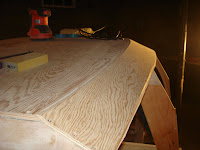It being Labor Day, we decided to do some labor. We have been planning out how we would shape the keel for several weeks. We didn't want to experiment with the piece of mahogany we had for the finished keel, so we took a piece of left over 1/4" plywood for the shaping job.

We laid it along the bottom center line of the pram and using a block of wood with a felt tipped pen taped to it, we drew the curved bottom line on the piece of plywood.

Then we cut that line out with our saber saw.

We shaped the resulting curved cut so it fit along the bottom of the boat nicely. Next we clamped the pattern onto the piece of mahogany and made sure we had enough board to make the necessary depth for the keel. We drew our curved line on the mahogany and marked the points at which it had to be certain depths.

After removing our pattern, we used a compass to draw the curved aft end of the keel and then used one of our battens to draw the fared shape of the keel.

Now the keel is ready to cut out on a friend's band saw. Since we will have the use of the band saw, we decided to mark the shape of the rudder and cut that out also.
This may seem like an overly detailed explanation of the process, but if you (like us) are not an experienced boat builder it takes a little doing to figure out a way to accomplish the job. We also have not been able to find any guidance on the web or in the book. So, here is how we did it.



















































